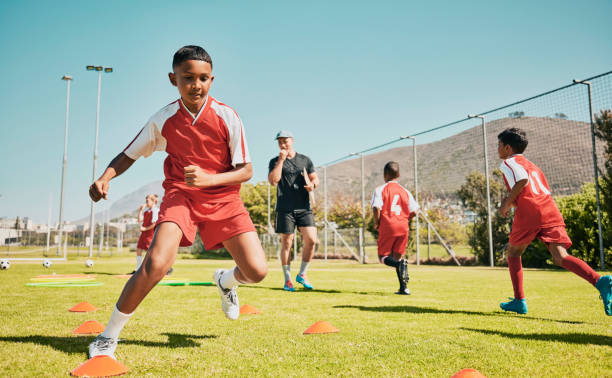It breaks my heart to see a young athlete’s dreams shattered by an injury that could have been prevented. I’ve lived through this, watching my own kids pour their hearts and souls into their sports, only to be sidelined by something that never should have happened. It’s a deeply disturbing trend in youth athletics, especially in the middle and high school years: this relentless, almost obsessive, push for “toughness” through sheer volume and repetitive drills.
What I witnessed was a system fixated on “more.” More reps, more drills, more hours on the field. The prevailing mentality seemed to be that the only way to forge a strong athlete was to push them to their absolute breaking point, day in and day out. The essentials—the crucial building blocks of proper training like weight training, stretching, and adequate recovery—were almost completely ignored. It was a disaster waiting to happen. And the consequences were devastating. So many young athletes were constantly battling injuries, often the same injuries recurring time and time again. It wasn’t just bad luck; it was a direct result of this fundamentally flawed approach. It became painfully clear that these weren't isolated incidents; they were a symptom of a much larger problem: a profound misunderstanding of what it truly means to build a resilient athlete.

As a clinician, I saw first-hand as angered and frustrated parents came to seek acute care for injuries sustained by their children either during a game or practice, with video evidence of the time of the injury, yet the young athlete forced to continue despite it all. I personally saw my son suffer a shoulder subluxation during a basketball game to only be placed on the bench with an icepack. At which point I made my way across the court and reduced the shoulder by myself. The expectation for these young athletes is to be tough and continue forward. A young football player will now suffer from chronic back pain at a young age due to a nagging, recurring back injury which, due to the ongoing training volume required surgical intervention now limiting his range of motion and shattering his athletic dreams.
The simple truth is that without the necessary support and recovery, this approach to training and sports participation will inevitably lead to overuse injuries with some suffering irreparable damage along the way. I know, as parents we want our children to be and become the very best. We want to give them everything, so how do we curb that drive and willingness to participate? It is a challenge as they, as you might have already experienced, will say and do anything just to participate in the sport they love despite the possibility that it might potentially be detrimental to their own development and goal aspirations. I feel you. I’ve been there myself. It can be a gut-wrenching experience.
Commonly, children who participate in sports activities, especially if they’re overtly driven and competitive, often feel a strong desire to win and outperform their peers. Not to mention the fear of not being able to play or participate in their selected sports. This is true for most sports. Thus, the high incidence of overuse injuries and other training associated misgivings. These overuse patterns can happen in all sports but mostly in sports where running, jumping, and kicking are constant, these injuries are incredibly common. Some of the most frequent ones I’ve seen include:
- Patellar Tendinitis (Jumper's Knee): This excruciating condition stems from inflammation or damage to the patellar tendon, often triggered by frequent jumping and rapid changes in direction. It’s a hallmark overuse injury in sports involving explosive movements. Athletes normally complain of pain in the anterior part of the knee and when they bend the knee. This is usually mild and then gets worse. It is most commonly noted after a long practice session or game.
- Shin Splints: Another common complaint, characterized by intense pain in the lower leg due to inflammation of muscles, tendons, and bone tissue. The repetitive stress of running and jumping is a major contributing factor, particularly for athletes who spend a lot of time on their feet. In some athletes these can be debilitating as they can be quite painful during running or jumping. Others may not have notable pain and are only aware of this condition when there is direct contact to the tibial bone.
- Stress Fractures: These are tiny cracks in the bone caused by repeated stress. Athletes who play or run on hard surfaces, are particularly vulnerable to stress fractures in their lower legs, feet, and ankles. This can be particularly detrimental as they may require 6-8 weeks of rest.
- Sprains and Strains: These injuries, especially in the ankles and knees, are common and prevalent across all levels of soccer. They often result from twisting or awkward landings.
This isn't just about treating injuries after they occur; it’s about proactively preventing them. It’s about establishing a solid foundation of strength, flexibility, and, crucially, proper recovery that will support young athletes not just for the season, but throughout their entire athletic journey and beyond. Overtraining in young athletes is a serious concern, with far-reaching consequences for both their physical and mental well-being.
Here are some of the key signs to watch out for:
- Persistent Fatigue: A constant state of tiredness that doesn't improve with rest. I know, they’re teenagers and they’re “always tired” but this time they might have a point.
- Decreased Performance: A noticeable decline in athletic performance despite continued training. This may manifest as frustration and outbursts of anger as they are unable to participate at their usual and desired level.
- Mood Changes: Increased irritability, anxiety, or even depression. As discussed above, this is usually related to their performance and fatigue level.
- Sleep Disturbances: Difficulty falling asleep or staying asleep. This is part of a vicious cycle. If they are unable to get restful sleep, consequently they are chronically fatigued. This leads to improper recovery, decreased performance and / or mood changes.
- Frequent Injuries: Recurring injuries, particularly overuse injuries like stress fractures or tendonitis.
- Loss of Interest: A diminished enthusiasm for the sport or activities they once loved.
Common causes of overtraining include:
- Lack of Rest: This isn't just about skipping a rest day; it is related to insufficient recovery time between training sessions.
- High Training Volume: Excessive training hours or intensity. This isn't just about long practices; it's about pushing young bodies beyond their limits, day after day.
- Specialization: Focusing on a single sport year-round without breaks and continued unrelenting pressure.
- External Pressure: Pressure from parents, coaches, or peers to consistently perform at a high level and only focusing on winning and performance which creates the expectation for continued effort and exertion.
I want to make something exceedingly clear; I must admit that to a certain level I’m guilty of most if not all the above.; both as an athlete and as a parent. Years of competition and military training and doctrine may have something to do with it but enough of excuses. This is why I would like to help you learn from our mistakes and be better, both for you and your children. Let’s get to it.

To truly protect our young athletes from the devastating consequences of overtraining, we must move beyond simply managing symptoms and instead address the root of the problem with compassion and understanding. The 5 elements required include:
- Nurturing Balanced Training: It's not enough to just switch up drills occasionally. We need to foster a love of movement and a holistic approach to athleticism. This means embracing a variety of activities and sports, allowing young bodies to develop in a well-rounded way and minimizing the risk of overuse injuries that can derail their dreams. Imagine the joy of a child rediscovering the simple pleasure of play, free from the relentless pressure of specialization.
- Honoring the Power of Rest: Rest isn't weakness; it's the bedrock of recovery and growth. We need to shift the culture from glorifying endless grind to celebrating the wisdom of rest. This means prioritizing adequate sleep, not as a luxury, but as a fundamental necessity for physical and mental well-being. Picture a child waking up refreshed and energized, ready to embrace the challenges of the day, rather than dragging themselves through another grueling practice.
- Becoming Attuned to Their Needs: We need to become vigilant guardians of their well-being. This means carefully monitoring training intensity and volume, not just through spreadsheets and data, but through genuine observation and connection. It means learning to recognize the subtle warning signs of overtraining—the persistent fatigue, the declining performance, the changes in mood—before they escalate into serious problems. Imagine the relief of a child knowing that their struggles are seen and understood, that they're not just a number on a roster.
- Creating a Sanctuary of Open Communication: This is perhaps the most crucial element. We need to create a safe and supportive environment where young athletes feel comfortable sharing their struggles, their fears, and their pain—both physical and emotional—without judgment or fear of reprisal. Imagine the weight lifted off a child's shoulders when they finally feel empowered to speak their truth, knowing that they will be heard and supported. This rung particularly true as this was one of the primary aspects I lacked growing up and would rather not speak out regarding injury or illness to my parents.
- Building a Collaborative Team of Support: No one can do this alone. Like the saying goes “It takes a village...” We need to build a strong network of support around each young athlete, including knowledgeable coaches, experienced healthcare professionals, and, most importantly, you, the loving and understanding parents. This collaborative team can work together to develop a balanced training plan that prioritizes long-term health and well-being over short-term gains. Imagine the peace of mind knowing that your child is surrounded by a team of caring adults who are all working together to support their dreams in a healthy and sustainable way.
By embracing these principles, we can move beyond simply preventing injuries and begin to cultivate a culture of true athletic well-being, where young athletes can thrive not just on the field, but in all aspects of their lives.
Like us on Facebook and Instagram. Become part of the ACTOS community and visit myactos.com for further tips and resources.
Gaspar
ACTOS, Performance Innovation
*Dr. Gaspar A. Rosario is a seasoned healthcare expert with a Doctorate in Health Sciences and over a decade of clinical experience. His certifications in Weight Management, Performance Enhancement, and Exercise Therapy from the ISSA, coupled with his diverse medical background, position him as a trusted authority in the field.

